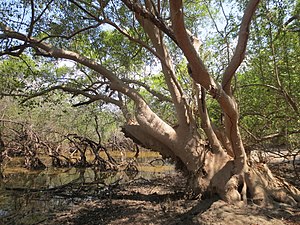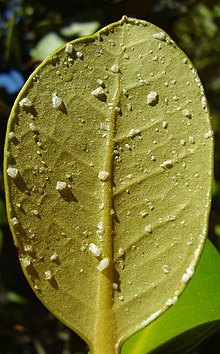Avicennia marina
| Avicennia marina | ||||||||||||
|---|---|---|---|---|---|---|---|---|---|---|---|---|

Large Avicennia marina on the shores of Lake Malai , East Timor |
||||||||||||
| Systematics | ||||||||||||
|
||||||||||||
| Scientific name | ||||||||||||
| Avicennia marina | ||||||||||||
| ( Forssk. ) Vierh. |
Avicennia marina is atype of mangrove from the genus Avicennia ,also known as the gray mangrove , which occurs from the east coast of Africa through Asia and Australia to Fiji . In terms of latitude and longitude, it has the largest distribution area of all mangrove species.
The entire genus Avicennia is characterized by respiratory roots that protrude vertically from the ground at regular intervals and the excretion of salty fluid on the leaves. If the liquid dries, numerous salt crystals develop, which are clearly visible on the leaves.
description
Manifestation
Avicennia marina is an evergreen tree that, under favorable conditions, reaches heights of growth of 30 meters and forms wide treetops. Under less favorable conditions and on the edge of the range, the species grows shrub-like , for example on the North Island of New Zealand .
Root system
Several meters long, flat roots extend from the base of the trunk . As with other Avicennia species, these form pneumatophores (respiratory roots) at regular intervals , which protrude up to 30 centimeters vertically and end in a clearly defined point. The respiratory roots are rarely branched and have a cork-like surface. They serve to supply the root system with oxygen , which is not sufficiently available in the silt soil. In addition, roots growing into the soil are formed, which serve for anchoring and nutrient absorption. These become a little longer than the roots of the breath and branch out. Avicennia marina sometimes also forms stilt roots , which is otherwise rare in Avicennia species.
Bark and wood
Avicennia marina has a gray, scaly, peeled bark covered with cork pores and has yellowish-green spots. The wood does not form annual rings , but has a band structure of xylem and phloem bands, which are separated from each other by sclerenchyme . The number of rings is only determined by the trunk diameter and is independent of external influences. The age of the tree cannot be inferred from the band structure.
leaves
The leaves are opposite to each other . The leaf stalks are up to three inches long, have yellowish hairs and are furrowed. The leathery leaf blade is ovate and rounded at the tip of the leaf. The veins are inconspicuous, the midrib protrudes from the underside of the leaf. The top is smooth, the underside covered with numerous small hairs, which cause the slightly grayish to olive green color. To regulate the salt balance, there are salt glands on both the upper and lower sides of the leaves, which secrete a salty liquid. If the liquid dries, salt crystals will form on the leaves.
Flowers and fruits
The flowers are in panicle-like inflorescences, are radially symmetrical, yellow-orange, fragrant and have a diameter of up to six millimeters. The corolla is four-lobed and largely hairless with the exception of small glandular hairs. The stamens are short, a maximum of two millimeters long and do not protrude from the flower. The stamens are about the same length as the stamens. The ovary is two to three millimeters long with a short, smooth stylus . Bees are responsible for pollination.
The capsule fruits have a diameter of two centimeters and a round to somewhat oval shape. The seed germination takes place in the fruit without the seedling leaving the fruit before it falls off.
Chromosome number
The number of chromosomes is 2n = 36, 64 or 96.
Distribution and location requirements
The distribution area of the species extends from East Africa across the Red Sea along tropical and subtropical coasts of the Indian Ocean to the South China Sea . They can be found on the coasts of Australia and the North Island of New Zealand , on islands of Polynesia and Fiji . The distribution area is between 25 ° north and 38 ° south latitude .
Mangroves occur on tropical and subtropical ocean coasts. Their environment is characterized by the salt water, the tides, the underground consisting of oxygen-poor silt and high temperatures and high humidity. They are not dependent on salt water, but can also survive on the arms of freshwater rivers. Avicennia marina shows optimal growth with a salt content that is about half that of sea water.
Avicennia marina is listed as Least Concern on the IUCN Red List .
Systematics
A distinction is made between several varieties, with strong overlaps in the assignment. At least three varieties can be distinguished through genetic testing:
- Avicennia marina var. Marina occurs on the west coast of Australia and the areas to the west. It differs from the other varieties by the larger corolla and the hairy calyx.
- Avicennia marina var. Eucalyptifolia (Val.) NCDuke on the north coast of Australia. It has elongated leaves, a hairy calyx and a smaller corolla.
- Avicennia marina var. Australasica on the east coast of Australia and areas to the east with hardly hairy calyx.
| Avicennia marina |
|
||||||||||||
|
|
The varieties marina and eucalyptifolia are more genetically similar. The differences suggest a separation only about 200,000 years ago, in the case of the australasica variety, a separation about 2 million years ago. Deviations of up to a factor of 20 are possible for both values. However, a separation as early as the Cretaceous can be ruled out. The separation between var. Marina and var. Eucalyptifolia could have occurred in the Ice Age, when a land barrier separated the further east occurring variety marina from the further west lying eucalyptifolia due to the sunken sea level . The influence of this barrier could also be determined for various animal species found in the sea.
From a morphological point of view, Moldenke differentiates between the following varieties:
- Avicennia marina var. Marina with a distribution area from East Africa over the Red Sea to Australia.
- Avicennia marina var. Resinifera (G.Forst.) Bakh. with compact inflorescences of two to twelve flowers, elongated-elliptical leaf blades with pointed to pointed apex. Their occurrence extends from Sumatra to Australia, the North Island of New Zealand , New Caledonia , New Guinea to the Philippines . The number of chromosomes is 2n = 64 or 96.
- Avicennia marina var. Rumphiana with long petioles from 1.5 to 3 centimeters. The distribution area extends from Malaysia through New Guinea to the Philippines.
- Avicennia marina var. Anomala Moldenke with smaller inflorescences. The distribution area is limited to Queensland .
- Avicennia marina var. Acutissima Stapf & Moldenke with particularly pointed leaf tips. The distribution area is limited to the area around Mumbai .
The following other varieties not recognized by Moldenke are mentioned:
- Avicennia marina var. Intermedia with a distribution area from Malaysia to New Guinea and the Philippines. The variety differs in its oval-round shape, the short petioles of maximum 2 millimeters in length and the small fruits. At Moldenke, this group is included in the marina variety .
- Avicennia marina var. Australis , the name should not have any taxonomic meaning, but only reflect a geographic condition.
use
The species has a variety of uses in traditional societies. Dugout canoes are made from thick trunks. The wood, which is resistant to insects because of its salt content, is also used for furniture and in boat building. It is also resistant to termites. It does not have the best reputation as firewood, but because of its great availability it is used for this purpose and for making charcoal.
At night, the green wood is often used as an insect repellent, as it burns slowly and with a lot of smoke, which keeps mosquitoes away. Honey collectors also use this property to open beehives.
The flowers give off nectar that attracts bees. At least in New Zealand, the species is used as a bee pasture.
proof
literature
- P. B. Tomlinson: The Botany of Mangroves . Cambridge University Press, Cambridge 1986, ISBN 0-521-46675-X .
- Duke, Benzie, Goodall, Ballment: Genetic Structure and Evolution of Species in the Mangrove Genus Avicennia (Avicenniaceae) in the Indo-West Pacific. (PDF; 371 kB) In: Evolution. The Society for the Study of Evolution, 1998, pp. 1612-1626 , accessed May 21, 2009 .
Individual evidence
- ^ Tomlinson: The Botany of Mangroves . P. 191
- ^ Tomlinson: The Botany of Mangroves . P. 194
- ↑ a b c d Tomlinson: The Botany of Mangroves . P. 201
- ^ Tomlinson: The Botany of Mangroves . P. 186
- ^ Tomlinson: The Botany of Mangroves . Pp. 195-197
- ^ Tomlinson: The Botany of Mangroves . P. 187
- ^ Tomlinson: The Botany of Mangroves . P. 121
- ↑ a b Tomlinson: The Botany of Mangroves . P. 195
- ^ Avicennia. In: Flora of China Vol. 17. www.eFloras.org, p. 49 , accessed on June 15, 2009 (English).
- ↑ a b Avicennia at Tropicos.org. In: IPCN Chromosome Reports . Missouri Botanical Garden, St. Louis
- ^ Tomlinson: The Botany of Mangroves . Pp. 200-201
- ^ Duke et al .: Genetic Structure and Evolution of Species in the Mangrove Genus Avicennia (Avicenniaceae) in the Indo-West Pacific . P. 1612
- ^ Tomlinson: The Botany of Mangroves . P. 127
- ↑ Avicennia marina in the endangered Red List species the IUCN 2010. Posted by: N. Duke u. a., 2008. Retrieved on January 3, 2011.
- ^ Duke et al .: Genetic Structure and Evolution of Species in the Mangrove Genus Avicennia (Avicenniaceae) in the Indo-West Pacific .
- ^ Duke et al .: Genetic Structure and Evolution of Species in the Mangrove Genus Avicennia (Avicenniaceae) in the Indo-West Pacific . Pp. 1621-1622
- ↑ HN Moldenke: Material towards a monograph of the genus Avicennia L. I and II . In: Phytologia . tape 7 , 1960, pp. 123-263 . ; HN Moldenke: Additional notes on the genus Avicennia I and II . In: Phytologia . tape 14 , 1967, p. 301-336 . quoted from Tomlinson: The Botany of Mangroves . Pp. 201-202
- ^ Tomlinson: The Botany of Mangroves . P. 202
- ^ David John Mabberley: Mabberley's Plant-Book. A portable dictionary of plants, their classification and uses . 3rd ed., Page 83. Cambridge University Press 2008. ISBN 978-0-521-82071-4
- ↑ F. Dahdouh-Guebas, C. Mathenge, j. G. Kairo, N. Koedam: Utilization of Mangrove Wood Products around Mida Creek (Kenya) Amongst Subsistence and Commercial Users . In: Economic Botany . tape 54 (4) . The New York Botanical Garden Press, Bronx, NY 2000, pp. 513-527 ( online [PDF; accessed October 18, 2011]).
Web links
- Avicennia marina. In: Flora of China Vol. 17. www.eFloras.org, p. 49 , accessed on June 15, 2009 (English).





